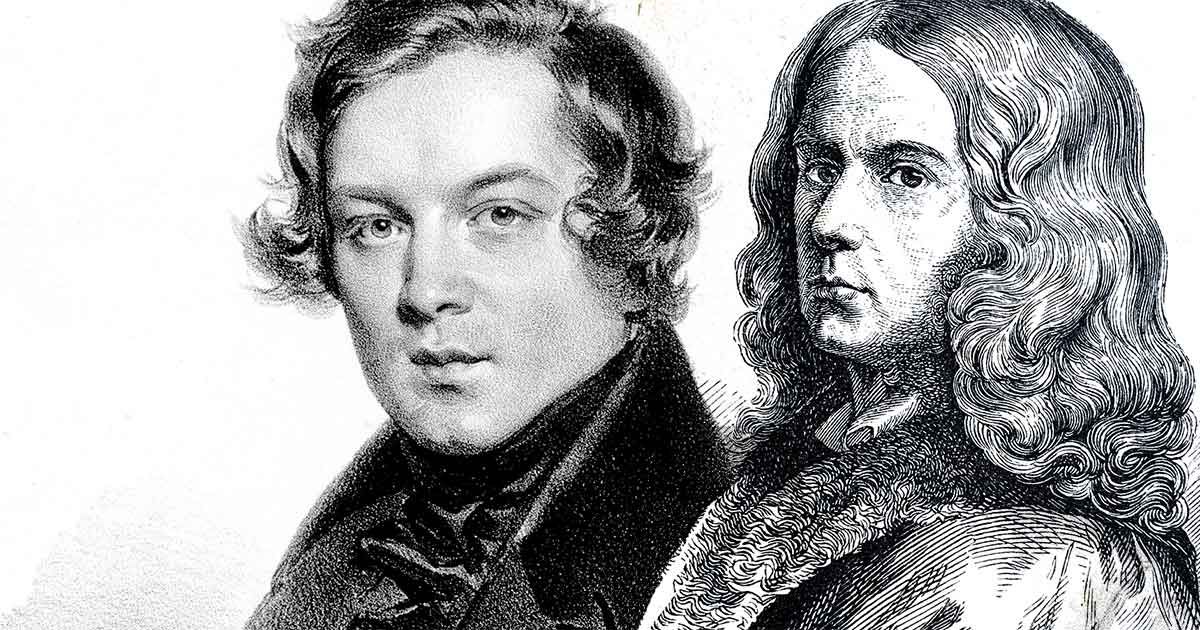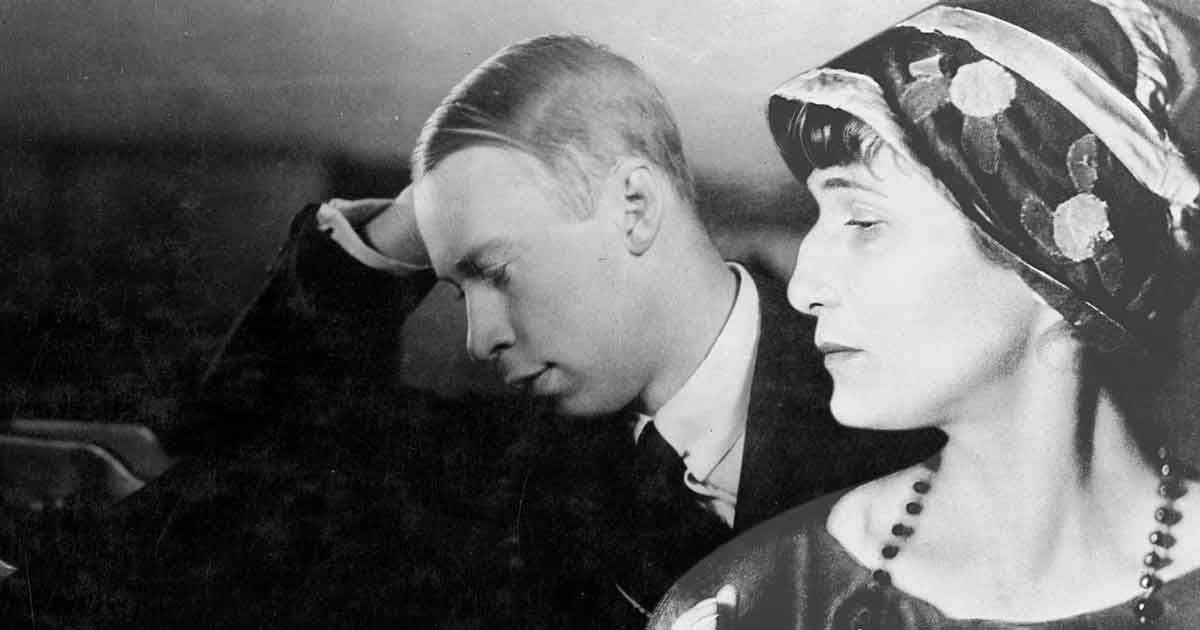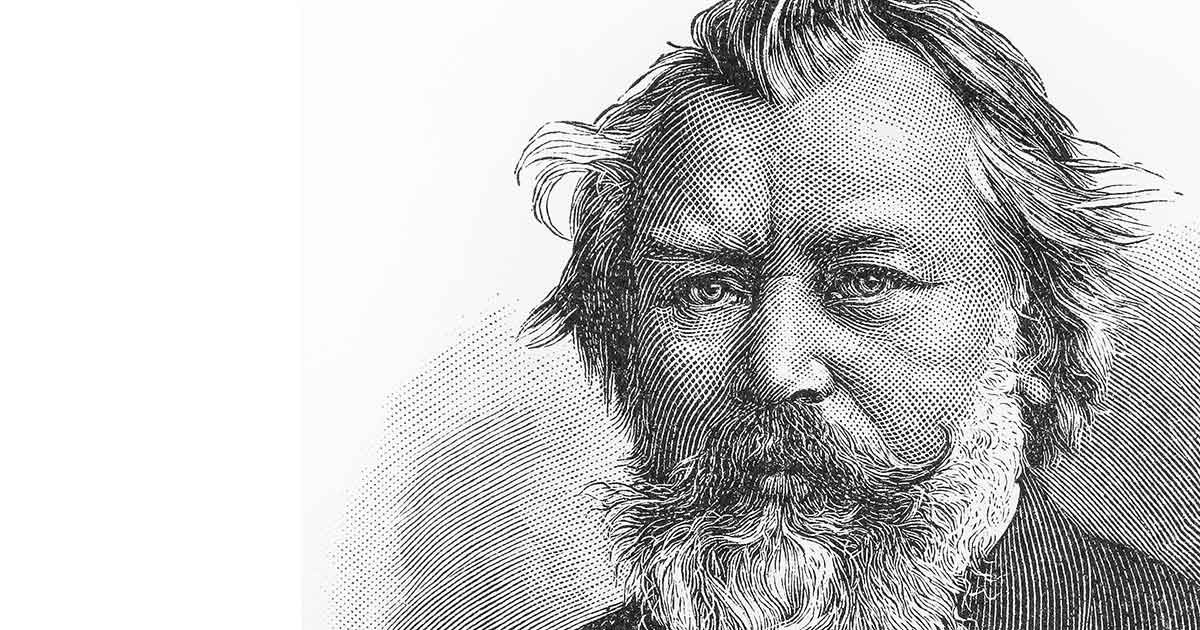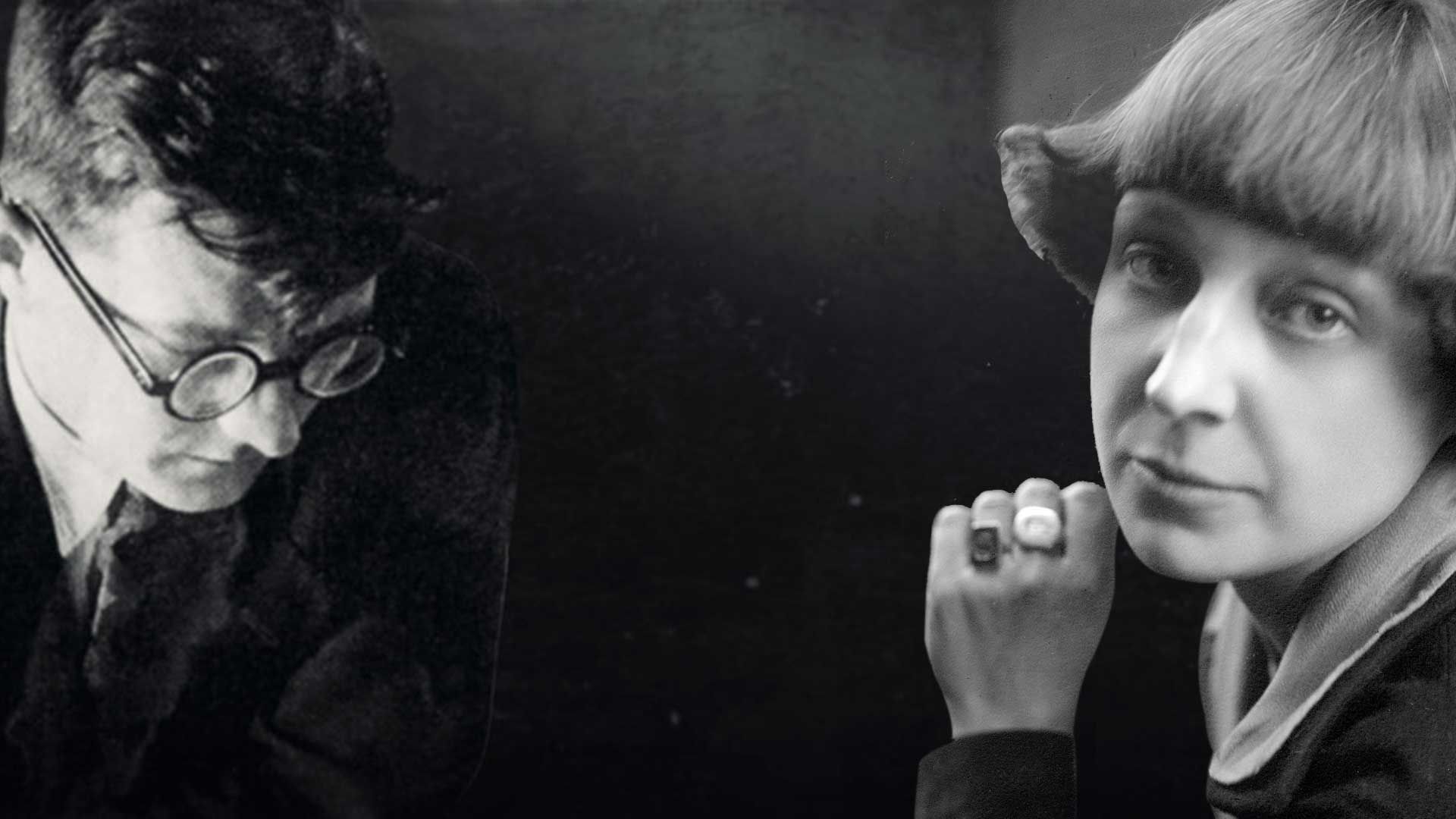
Concert
MUSIC, POETRY
AND THE RUSSIAN POETESSES
Playbill
Robert Schumann (1810 – 1856), Frauenliebe und Leben Op. 42 for soprano and piano
Sergei Prokofiev (1891 – 1953), Five Poems for soprano and piano to poems by Anna Akhmatova Op. 27
Johannes Brahms (1833 – 1897), Zwei Gesänge Op.91 for mezzo-soprano, viola and piano
Arnold Schoenberg (1874 – 1951), Due Lieder Op. 14 for soprano and piano
Dmitri Shostakovich (1906 – 1975), Shest’ stikhotvorenii Marini Cvetajevoj (Six Poems of Marina Tsvetayeva) Op. 143
Musicians:
Sophie Gallagher, soprano
Xeni Tziouvaras, mezzo-soprano
Gianni de Rosa, viola
Clive Britton, piano

Robert Schumann (1810 – 1856)
Frauenliebe und Leben Op. 42
for soprano and piano
lyrics by Adelbert von Chamisso
Seit ich ihn gesehen
Er, der Herrlichste von allen
Ich kann’s nicht fassen, nicht glauben
Du Ring an meinem Finger
Helft mir, ihr Schwestern
Süsser Freund, du blickest mich verwundert an
An meinem Herzen, an meiner Brust
Nun hast du mir den ersten Schmerz getan
It is not difficult to imagine how a musician with such a deep knowledge of literature as Schumann was attracted and enchanted by the poetry of Chamisso. There was a time in Schumann’s life when the pale, emaciated figure created by Peter Schlemihl became a part of his imaginary world. It was 1838, Chamisso’s last year on earth and the year in which Schumann travelled to Vienna.
A nobleman of French descent, Louis Charles Adelaide Comte de Chamisso was born in Champagne. When the revolutionaries destroyed the Château de Boncourt, his family was forced to emigrate to Germany. He was only nine years old. So, as Thomas Mann pointed out in admiration, one of Germany’s most celebrated poets was a foreigner!
Chamisso began to feel German in 1815 when he realised, on being appointed as a naturalist on a voyage to the Indian Ocean, that the homeland he missed was not France. While sailing around the world, the first European to contemplate the huge figures on Easter Island, this man who was not yet a poet but was on the verge of becoming a scientist, understood that the only homeland for which he felt homesick was Germany.
In his Frauenliebe und Leben op. 42 cycle, Schumann provides Chamisso’s poems with one of their most brilliant showcases. Dedicated to the 38-year-old poet’s extremely young wife, the cycle’s theme is the love of a woman. The husband, the family man, the revered maestro, wished to speak with the heart of a woman and he did so in a manner so overflowing with ecstatic devotion that it sounds anachronistic to our modern ear. Schumann translated the poet’s ideas and words into a musical score that lends substance to the uncertainty of love, to joy, to fullness and to pain in a vision which transcends all concept of time.
While what Bortolotto said with such brilliant lucidity years ago, namely that moving from Schubert to Schumann is like descending from heaven to earth, may be true, it is equally true that Schumann’s Lieder depict the eternal present of our being in the world. From the very first Lied, Seit ich ihn gesehen (Since First Seeing Him), we realise that Schumann’s time is a bizarre time which does not need heaven to conquer eternity, it is sufficient for it to move in life. Is what we perceive in his compositions not the lasting present of human life? What has been for some is what is today for others and what will be in the future present for yet others. Each one of us can identify the moments of our life in Schumann’s music because he has the ability to translate into sound the poetry of every single moment, of that daily atmosphere of which we all partake. And everything leads back to a harmonious unity of meaning.
The first Lied with its ecstatic succession of chords, tells of the spell of love at the very moment in which it appears. Love has not yet revealed its pathos, only its firm, dominating, enchanting force. Full awareness of the mutual feeling comes in the second Lied, Er, der herrlichste von allen (He, the Most Wonderful of All), where piano and song alternate in melodic outburst and often perform together. It is hardly surprising that we hear a frequent repetition of the gruppetto, which for Schuman was the musical figure of loving affection. Time and history appear to have stood still once again in the third Lied, Ich kann’s nicht fassen, nicht glauben (I Cannot Grasp It, Believe It) where the woman, surprised by a declaration of love, cannot believe the happiness she will be feeling. Never more than in the moment of happiness does love feel like a dream. O laß im Traume mich sterben, says the woman, let me die in this dream, as though dying were the only condition akin to love, capable of freezing existence into something that can last for ever.
Thus, the role of a tangible symbol of love falls to the ring – Du, Ring an meinem Finger (You, Ring on my Finger). In music it takes on concrete form with a stubborn assertion of the perfect fifth interval (e – b – e). The fifth, which Schumann associated with marriage, forms (according to Stricker) the backbone of the harmonious curve of the theme and is heard at the start of each of the two verses. There are no words to explain happiness, other than the reiterated promise of the woman who devotes her own life to the happiness of her beloved.
We then encounter the moments of ecstatic abandon with Helft mir, Ihr Schwester (Help Me, My Sisters), which solemnises the wedding day, whilst the piano echoes the sound of festive bells. Süßer Freund, du blickest Mich verwundert an (Sweet friend, You Look) opens with a recitative in which the woman announces to her husband that she is expecting a child. In the central part of the Lied, the poem opens up to the melody and out of Schumann’s subconscious there emerges an echo of Beethoven’s distant beloved.
The final verse returns to the recitative with thoroughly interior concision. An meinem Herzen, an meiner Brust (On My Heart, at My Breast) is the final moment of happiness assuaged. The earthly essence of love comes alive in all its force thanks to a lyric in which rhetorical figures are triumphant – not only rhyme but also the interior echoes of the anastrophe, du meine Wonne, du meine Lust, the call, Das Glück ist die Liebe, die Lieb’ ist das Glück. Almost as though the idea were to highlight the dual happiness of someone who is not only happy, but knows that he or she is happy. The final Lied, Nun hast du mir den ersten Schmerz getan (Now You Have Caused Me My First Pain), is the farewell, the death of the beloved, and here Schumann entrusts the leave-taking to the piano with the chords of the first page. When the voice is silent, the rest of the world is silent and the poet speaks, as in the conclusion of the Kinderszenen. Enshrined in this piano framework, the story and the music tell of becoming and vanishing and the cycle ends omitting the final lyric of Chamisso who, in the poetic cycle, left the farewell to the woman portrayed in old age as she narrates and remembers her life and love, for both our and her own benefit.

Sergei Prokofiev
Five Poems, op. 27
for soprano and piano
to poems by Anna Akhmatova
Prokofiev’s name is solidly bound to the production of opera, orchestra music, music for the piano and ballet, with compositions marked more often than not by a strong and original creative personality that feeds largely on the natural sources of Russian melos, as in the case of his Five Lieder on Poems by Anna Akhmatova, who had recently died. He composed in 1916 between two extremely interesting collections of piano music with broad appeal, his Vision Fugitives op. 22 (1915-1917) and his Tales of an Old Grandmother op. 31 (1918), and a year before his popular Classical Symphony.
The five melodies hark back to a neo-Musorgskyian expressive mood, to the point where we can argue that a slender, yet clearly visible thread links these poems to the Children’s Bedroom cycle, with which they share the same delicate, suffused melodic and harmonic intimacy. In these album sheets with their plain musicality (they last ten or elevent minutes), the composer describes various states of mind. In a game between reality and dream, in which the dominant element is the sense of melancholy and sadness for a distant dear one expected to return, as we can see in the page entitled The True Tenderness, Thoughts of the Sun and, above all in the final page entitled The Grey-Eyed King so heavily charged with late Romantic sentimental anguish and on an aesthetic level that so clearly contrasts with the level subsequently pursued by the composer himself.

Johannes Brahms
Zwei Gesänge, op.91
for mezzo-soprano, viola and piano
In his Two Lieder for contralto, viola and piano op. 91, Brahms places the contralto voice and the viola on an equal footing, exchanging registers and motivic materials in a sophisticated exploration of musical colours and timbres. The origin of these two musical gems lies in Brahms’s friendship with the violinist Joachim and his wife Amalie, a celebrated contralto of the time. On their marriage in April 1863, Brahms sent Joachim “a wonderful Catholic poem, a marvellous lullaby” entitled Resonet in laudibus (known in Germany as Josef, lieber Josef mein), which he himself had discovered in two collections dated 1631.
To mark the birth of Joachim’s firstborn son in September 1864, Brahms sent the couple an early version of Geistliches Wiegenlied, an adaptation of Emanuel Geibel’s poem based on a piece by Felix de Vega Carpio, in which the ancient melody provides material for the introduction of the viola, for the interludes and for the epilogue. Even though the manuscript was circulating among Brahms’s friend, the lyric had wait over twenty years to be published. It was finally published in 1884 along with his Gestillte Sehnsucht to poems by the German poet Friedrich Rückert, the product of a period of rest and relaxation spent in Mürzzuschlag in Styria from spring to autumn 1884. Gestillte Sehnsucht opens with a theme for the viola of considerable emotional intensity that immediately introduces us into the enchanting mood of “assuaged longing” of which Rückert’s poetry speaks.
In the first verse – In gold’nen Abendschein getauchet -, the main theme is initially entrusted to the viola before passing smoothly to the voice, while the viola imparts concrete sound to the images evoked by the lyrics ”while the wind murmurs, the small birds…” with lively arpeggio in semichrome. The second verse is in contrast, with its lively figurations for the viola and with a tighter voice for the contralto, paving the way for the final verse which is identical in form to the first verse.
The main theme, which opened the lyric, thus represents the page’s true element of formal cohesion, because Brahms uses it both as an introduction and instrumental epilogue and as a vocal finale for each verse. Geistliches Wiegenlied is a delightful lullaby, introduced by the viola that expounds on the theme of the poem Josef, lieber Josef mein, which returns at the end of each of the four verses that make up the lyric. The first verse is characterised by a serene melody rising in the voice, while the second is more lively when it reaches the words “You palms of Bethlehem in the raging wind, why do you bluster so angrily today!”. The tense, almost dramatic lyric in the third verse “The heavenly babe suffers distress” is softened in the peaceful return to the initial serenity.

Dmitri Shostakovich (1906 – 1975)
Shest’ stikhotvorenii Marini Cvetajevoj
Six Poems of Marina Cvetaeva, op. 143
Shostakovich’s final creative period revealed a growing interest in poetry on the composer’s part. In the space of a few years he produced a great deal of work involving voice and based on a meticulous selection of poetic texts, particularly by Russian authors. Shostakovich’s catalogue was thus considerably enriched with important and valuable scores: the Thirteenth Symphony known as “Babij Jar” for bass, men’s chorus and orchestra op. 113, to poems by Evtusenko (1962); the cantata “The Death of Stenka Razin” for bass, chorus and orchestra op. 119, once again to poems by Evtusenko (1964); the Seven Romances on Poems by Aleksander Blok, for soprano, violin, cello and piano op. 127 (1967); the Fourteenth Symphony, for soprano, bass and chamber orchestra op. 135, to poems by Garcia Lorca, Apollinaire, Rilke and Küchelbecker (1969); the Six Poems of Marina Tsvetayeva for contralto and orchestra op. 143a (1973-74) and the Suite on Verses of Michelangelo Buonarroti for bass and orchestra op. 145a (1975). His selection of poems, despite their very varied origin, focuses insistently on a few recurrent themes such as the artist’s relationship with power, censorship, war and a number of existential topics. Thus it is hardly surprising that the composer should have turned his attention to the verses of Marina Tsvetayeva.
The life story of this woman of letters is without doubt an emblematic and disturbing case in the history of Russian culture in the last century. Born into a highly educated family in 1892, Marina lived through the social upheaval spawned by the Revolution of 1917. She spent many years separated from her husband Sergey Efron, and she was forced to abandon a daughter in an orphanage where the daughter subsequently died of starvation. Tsvetayeva emigrated in 1922, first to Prague and then to Paris, but when she got there, she was cold-shouldered and found herself side-lined into the exiles’ circle. Finally, in 1939, she followed her husband back to Russia, but there too she encountered hostility and lived in appalling conditions. Another daughter was deported to a gulag, her husband was shot by firing squad and she herself was evacuated following the Nazi invasion. She took her own life in August 1941. Despite the tragedy of her life story, as an artist Tsvetayeva was driven by a strong sense of independence from schools and trends, and she was endowed with a romantic sensitivity, post-Symbolist inspiration and the cult of poetry as a means of overcoming the pain and sorrow of everyday life, as a practice of the absolute.
Shostakovich never met Tsvetayeva personally, only taking an interest in her poetry at a fairly late date when his pupil Tishchenko played him his musical version of some of her work in 1970. He was later to meet both her sister and daughter. He made the decision to turn his own hand to the task of setting some of her poems to music in August 1973, producing in the space of a few days an initial version of his Six Poems for voice and piano first performed on 30 October with the voice of contralto Irina Bogacheva, which the author felt might resemble that of Tsvetayeva herself thanks to a certain raucous quality caused by smoking. By January 1974 Shostakovich had already prepared a version for a small orchestra, generally considered to be a fundamental enrichment of the version for chamber orchestra.
For his musical cycle Shostakovich chose six poems that Tsvetayeva had written at very different moments in her life (1913, 1916, 1923, 1931, 1931, 1916) and that also differed considerably in their content. Yet his choice was so rationally pondered that the Six Poems, while not an interchangeable anthology, form a genuine cycle whose rationale unfolds with the pages. There is a direct match between the first and last piece. In the first, “To My Poems”, Tsvetayeva reveals her belief in the value of poetry and in its ability to cross time, while in the last, “To Akhmatova”, we discover similar concepts but in connection with the verses of Anna Akhmatova, another leading Russian poetess who also happened to look after Marina’s daughter after she committed suicide. Between these two pillars we can identify other paired poems. The second lyric (“Where Does Such Tenderness Come From?”) and the third (“Hamlet’s Dialogue with His Conscience”) address the dynamic of love and anger, while the fourth (“The Poet and the Tsar”) and fifth (“No, There Was Drumming”) explore the power of the poet’s verse. If we look closely, as Vera Vasina-Grossman explains, the theme of the cycle as a whole is “the fate of an artist” in whom “the personal fate of the lyrical heroine […] oscillates tragically between the [themes of] love and duty, love and death, and there is also the broader theme of the fate of the artist in the world around him, a theme personified by the image of Pushkin”, in the fourth and fifth lyric.
The reflection on fate, which plays such a large part in all of Shostakovich’s later work, with a strong autobiographical note, also runs through the cycle of six poems, not simply on account of the texts chosen but also on account of the way he has set them to music. One has but to look at the first one, “To My Poems”, where the poetess’s youthful enthusiasm and her gesture of proud confidence in her art is given a meditative, abstract sound environment that moves towards an intensification of expression. The composer opens the lyric with the slow exposure of the twelve notes and then, when he reaches the words “To My Poems” he plays us the musical symbol of his name, the fours notes DSCH (D, E minor, C, B natural, according to the Anglo-Saxon scale using letters of the alphabet), a revaling autobiographical reference that identifies the musician with the poetess.
This is followed by a pair of poems devoted to unsuccessful or inadequate love. A striking aspect in the writing of “Where Does Such Tenderness Come From?” is the gently rocking tone of voice combined with the emergence of parts for solo instruments. In “Hamlet’s Dialogue with His Conscience” what comes to the fore is the contralto’s jagged phrasing, with the hallucinating repetition of the expressions. The pair of poems dedicated to the poet marks a clear break with the meditative atmosphere: in the poem entitled “The Poet and the Tsar”, Tsvetayeva alludes to Pushkin’s censorship at the hands of Tsar Nicholas I and, in choosing that poem, it was only logical that Shostakovich should allude to his own censorship at the hands of the regime. The hymnodic and declamatory intonation chosen to intone these verses, underscored by the xylophone, has the makings of a fully-fledged accusation. In “No, There Was Drumming” Shostakovich resorts to one of his favourite moods, the grotesque, with a military march mockingly accompanying the dead poet’s secret funeral and reappearing later in the short postlude with a ghostly aura conjured up with superb mastery. In the final lyric, “To Akhmatova”, we rediscover the meditative and abstract mood of the first page but with a significant variant consisting in bells that ring from the outset, alluding to Tsvetayeva’s wish to give Anna Akhmatova her “city of bells”. But is this really the final lyric? The very structure of the cycle suggests an open finale or, perhaps even more accurately, a cyclical form that links the last lyric to the first under the banner of the primacy of poetry and of art.
